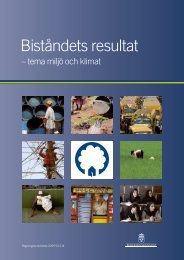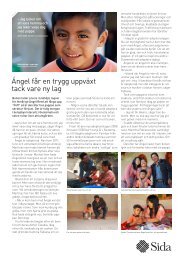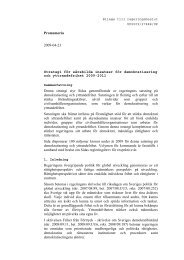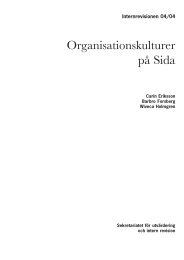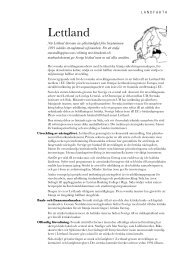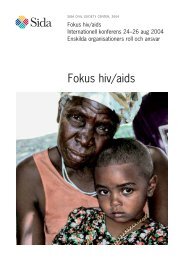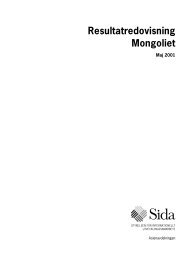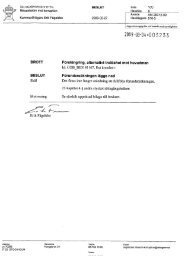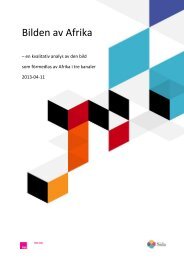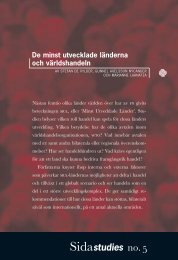Mobilisation of the Poor – a means to Poverty Reduction? - Sida
Mobilisation of the Poor – a means to Poverty Reduction? - Sida
Mobilisation of the Poor – a means to Poverty Reduction? - Sida
Create successful ePaper yourself
Turn your PDF publications into a flip-book with our unique Google optimized e-Paper software.
mobilisers, as well as moves <strong>to</strong> facilitate <strong>the</strong> federation <strong>of</strong> CAP small groups in<strong>to</strong> higher level<br />
organisations.<br />
For many years <strong>the</strong>re were discussions about how <strong>to</strong> scale up CAP (Abeygunawardana 1987).<br />
By 1990 <strong>the</strong> village cluster method <strong>of</strong> operation had been abandoned in favour <strong>of</strong> <strong>the</strong> Assistant<br />
Government Agent (AGA) model. Under <strong>the</strong> original social mobilisation model, core trainers were<br />
entrusted with <strong>the</strong> task <strong>of</strong> initiating <strong>the</strong> process <strong>of</strong> mobilisation in village clusters in collaboration with<br />
change agents and volunteers selected from within <strong>the</strong> local communities. In contrast, under <strong>the</strong> AGA<br />
model 25 <strong>to</strong> 30 volunteers were selected from each AGA division through local administrative<br />
<strong>of</strong>ficials, given rapid training in RDTRI training centres, and <strong>the</strong>n were required <strong>to</strong> initiate <strong>the</strong> social<br />
mobilisation processes in <strong>the</strong>ir respective areas under <strong>the</strong> supervision <strong>of</strong> one senior trainer per AGA<br />
division. This development paralleled <strong>the</strong> nationwide social mobilisation programme initiated under<br />
<strong>the</strong> Janasaviya Programme (Sirivardana 1998). By 1991, 20 AGA divisions in six districts were<br />
covered by CAP with a cadre <strong>of</strong> about 500 volunteers. The volunteers, who included government<br />
servants such as schoolteachers, community leaders, and social activists, were paid a modest<br />
allowance for <strong>the</strong>ir services under <strong>the</strong> CAP programme. While <strong>the</strong>re was no stated change in <strong>the</strong><br />
concept <strong>of</strong> mobilisation used in this period, <strong>the</strong> process was much abbreviated and each mobiliser was<br />
expected <strong>to</strong> achieve certain targets in respect <strong>of</strong> number <strong>of</strong> small groups formed, volume <strong>of</strong> group<br />
funds generated, and overall coverage <strong>of</strong> <strong>the</strong> programme in <strong>the</strong>ir respective areas. This certainly led<br />
<strong>to</strong> increased coverage <strong>of</strong> <strong>the</strong> programme but <strong>the</strong> quality <strong>of</strong> social mobilisation suffered, as no deep<br />
social probing was possible given <strong>the</strong> limited skills and time constraints <strong>of</strong> <strong>the</strong> new mobilisers. Despite<br />
this “s<strong>of</strong>tening <strong>of</strong> CAP methodology”, some continuing elements <strong>of</strong> <strong>the</strong> original CAP doctrine such as<br />
emphasis on self-reliance and mutual help among <strong>the</strong> poor and <strong>the</strong> articulation <strong>of</strong> collective interests<br />
among programme participants signified some continuity in <strong>the</strong> approach.<br />
Moves <strong>to</strong> federate small groups (primary organisations) in<strong>to</strong> village-level secondary organisations<br />
and AGA division-level tertiary organisations have been in progress since 1992 or so. This, in turn,<br />
facilitated <strong>the</strong> type <strong>of</strong> collective action that was <strong>to</strong>o big for small groups <strong>to</strong> undertake on <strong>the</strong>ir own,<br />
such as road building or bargaining with service organisations at a higher level. This was also seen<br />
as a move <strong>to</strong>wards facilitating participa<strong>to</strong>ry self-management <strong>of</strong> organisations involving <strong>the</strong><br />
mobilised rural poor.<br />
Transfer <strong>of</strong> responsibility for CAP activities <strong>to</strong> newly formed NGOs<br />
<strong>–</strong> 1995 <strong>to</strong> 2001<br />
Arrangements were made in <strong>the</strong> early 1990s <strong>to</strong> develop au<strong>to</strong>nomous organisations from among<br />
CAP members in preparation for <strong>the</strong> termination <strong>of</strong> <strong>Sida</strong> funding for <strong>the</strong> programme in 1998. The<br />
primary responsibility for continuing <strong>the</strong> CAP process has gradually been transferred from <strong>the</strong><br />
RDTRI <strong>to</strong> both <strong>the</strong> Prajashakti Organisations (PO) created at <strong>the</strong> AGA division level and <strong>the</strong><br />
national federation <strong>of</strong> POs, Prajashakti Maha Sangamaya (PMS). The POs have become primarily<br />
financial institutions with funds raised from member savings, membership fees, and funds obtained<br />
from donors for lending on <strong>to</strong> <strong>the</strong> rural poor. As external funding for CAP ran out, allowances for<br />
CAP workers had <strong>to</strong> be s<strong>to</strong>pped or reduced. This, in turn, reduced <strong>the</strong> external supervision or<br />
moni<strong>to</strong>ring <strong>of</strong> <strong>the</strong> programme, which lead <strong>to</strong> <strong>the</strong> gradual disintegration <strong>of</strong> some <strong>of</strong> <strong>the</strong> CAP groups.<br />
Since <strong>the</strong>n <strong>the</strong> new organisational structure, which is steered mainly by local POs, has gradually<br />
consolidated <strong>the</strong> group process. As <strong>of</strong> 1998 <strong>the</strong>re were 64 POs. By 2001 that had dropped <strong>to</strong> 53,<br />
but <strong>the</strong> group process remained largely intact in <strong>the</strong> more active POs, once again demonstrating a<br />
degree <strong>of</strong> resilience on <strong>the</strong> part <strong>of</strong> CAP groups. This resilience is an important pro<strong>of</strong> <strong>of</strong> <strong>the</strong> strength<br />
and effectiveness <strong>of</strong> <strong>the</strong> CAP methodology.<br />
16<br />
MOBILISATION OF THE POOR <strong>–</strong> A MEANS TO POVERTY REDUCTION <strong>–</strong> <strong>Sida</strong> EVALUATION 02/08




